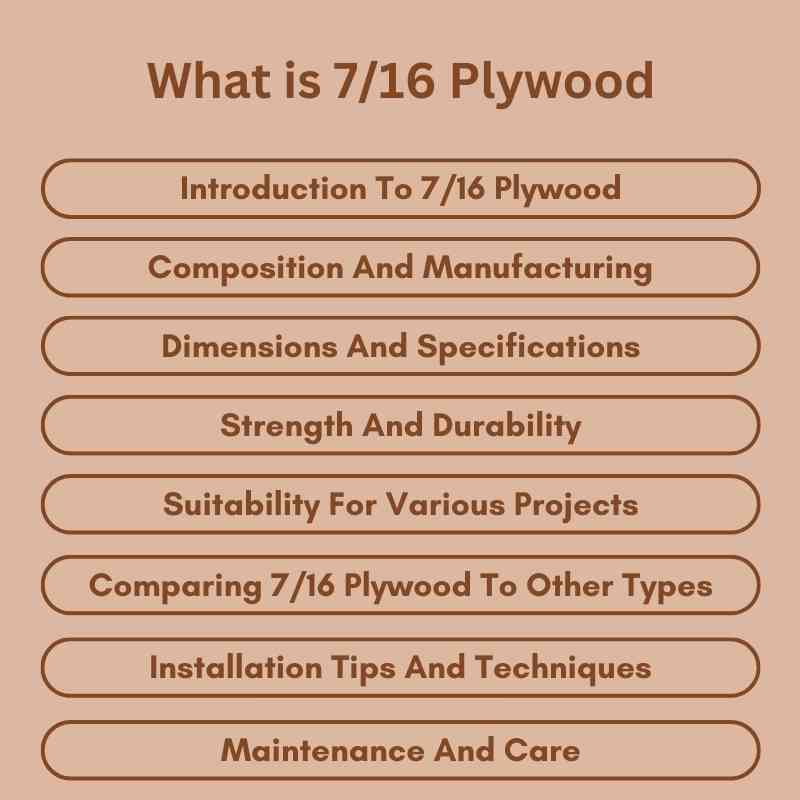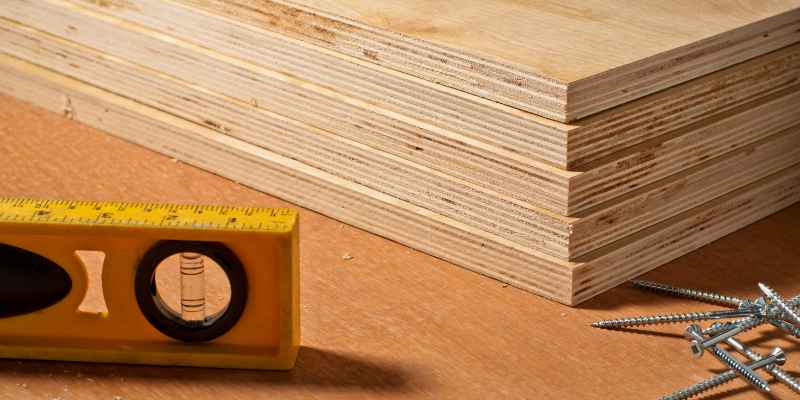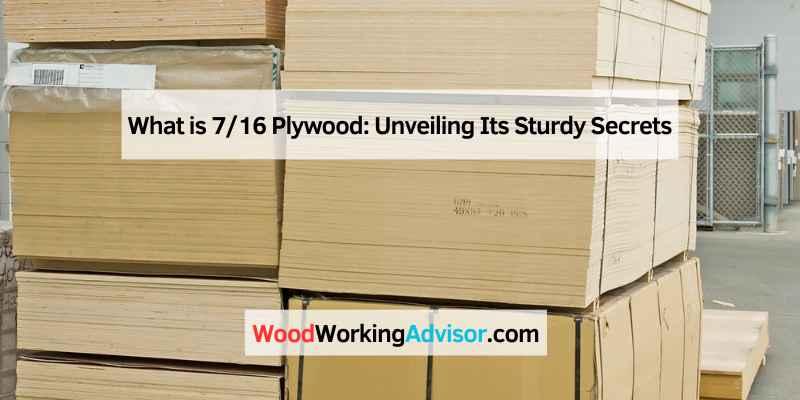7/16 plywood is a type of engineered wood panel that measures 7/16 inches thick. It is commonly used in construction and building projects for structural support.
Plywood is a versatile material made from thin layers of wood veneer glued together. The thickness of 7/16 inches makes it ideal for various applications, including flooring, sheathing, and cabinetry. Builders often choose this thickness for its balance of strength and weight.
It offers good resistance to warping and splitting, making it reliable in different environments. Available in various grades, 7/16 plywood can cater to both aesthetic and functional needs. Its affordability and durability make it a popular choice among DIY enthusiasts and professionals alike. Understanding its properties can help in selecting the right plywood for your next project.
Introduction To 7/16 Plywood
7/16 plywood is a popular building material. It is made from thin layers of wood. This plywood type has a thickness of 7/16 inches. Many builders use it for different projects.
The history of plywood dates back to ancient Egypt. They used thin sheets of wood for furniture. In the 20th century, plywood became common in construction. Today, many people rely on 7/16 plywood for its strength and versatility.
Common uses of 7/16 plywood include:
- Roof sheathing
- Wall panels
- Flooring underlayment
- Furniture making
This plywood type is easy to work with. It is lightweight yet strong, making it a favorite choice.

Composition And Manufacturing
7/16 plywood is made from thin layers of wood called veneers. These layers are glued together, creating a strong board. The main materials used include softwoods like pine and fir.
The production process starts with cutting logs into thin sheets. Next, these sheets are dried to remove moisture. After drying, the veneers are stacked and glued. Finally, the stack is pressed under high pressure.
Dimensions And Specifications
7/16 plywood is a common building material. It has a thickness of 7/16 inches. This plywood is often used in construction and furniture making.
Standard sizes for 7/16 plywood include:
| Size | Dimensions (inches) |
|---|---|
| 4×8 Sheet | 48 x 96 |
| 4×10 Sheet | 48 x 120 |
| 5×8 Sheet | 60 x 96 |
Common uses include walls, roofs, and floors. It offers strength and durability for various projects.
Always check the grade of plywood for quality. It affects performance and appearance.
Strength And Durability
7/16 plywood is known for its excellent strength and durability. It can support heavy loads, making it great for construction.
The load-bearing capacity is impressive. It stands strong under pressure without bending or breaking. This makes it ideal for floors and roofs.
Its lifespan is also noteworthy. With proper care, it lasts for many years. It resists wear and tear, making it a smart choice.
Wear resistance is key in high-traffic areas. The surface holds up well against scratches and impacts. This helps keep projects looking good over time.
Suitability For Various Projects
7/16 plywood is great for many indoor projects. It is strong and lightweight. Use it for walls, cabinets, and furniture. This plywood is easy to cut and shape. It can be painted or stained to match your style.
For outdoor applications, 7/16 plywood works well too. It is durable and can resist moisture. Use it for sheds, decks, and outdoor furniture. Applying a weather-resistant seal can help it last longer. Always check local building codes before starting your project.
Comparing 7/16 Plywood To Other Types
7/16 plywood stands out due to its cost-effectiveness. It offers a great balance between price and quality. This makes it a popular choice for many projects.
Compared to other plywood types, 7/16 plywood is often cheaper. It provides similar strength and durability. Homeowners and builders appreciate its affordability.
Many choose 7/16 plywood for construction and DIY projects. It fits budgets without sacrificing quality. Its versatility makes it ideal for various applications.
Installation Tips And Techniques
Cutting 7/16 plywood requires a sharp blade. Use a circular saw for straight cuts. A jigsaw works well for curves. Always measure twice before cutting to avoid mistakes.
Shaping the plywood can involve sanding edges. Use sandpaper to create a smooth finish. This step helps avoid splinters later.
Fastening plywood is crucial for strong joints. Use screws or nails for better hold. Make pilot holes to prevent splitting the wood.
Finishing can enhance the wood’s look. Paint or stain can be applied easily. Always let the finish dry completely before using the plywood.
Maintenance And Care
Keeping 7/16 plywood in good shape needs regular cleaning. Use a soft cloth and mild soap. Avoid harsh chemicals that can damage the surface. Rinse the plywood well after cleaning.
For upkeep, check for signs of wear. Look for scratches or dents. Fix any damage quickly to prevent bigger issues. Applying a sealant can help protect the plywood.
Preventing damage is key. Keep plywood away from moisture and extreme temperatures. Store it in a dry area. Using a protective cover can also help.
Environmental Impact And Sustainability
The sourcing of materials for 7/16 plywood plays a vital role in its environmental impact. Many manufacturers use sustainable wood sources. This helps reduce deforestation and promotes responsible forestry practices.
Using recycled materials is also common in plywood production. This practice helps save natural resources and reduces waste. Many companies focus on using certified wood from responsibly managed forests.
| Material | Sustainability Aspect |
|---|---|
| Wood | Sourced from sustainable forests |
| Recycled materials | Reduces waste and resource use |
| Adhesives | Low-VOC options available |
Disposing of 7/16 plywood should be done responsibly. Many local facilities accept plywood for recycling. This process reduces landfill waste and promotes the reuse of materials.
Composting is also an option for untreated plywood. This helps return nutrients to the soil. Always check local regulations for disposal methods.

Frequently Asked Questions
What Is 7/16 Plywood Used For?
7/16 plywood is commonly used for construction and structural applications. It is ideal for sheathing, roofing, and flooring. Its thickness provides strength and stability, making it suitable for various building projects. Additionally, it can be used in furniture making and cabinetry.
How Strong Is 7/16 Plywood?
7/16 plywood is quite strong, offering excellent load-bearing capabilities. Its layered construction enhances durability and resistance to warping. This strength makes it suitable for both residential and commercial applications. Properly installed, it can withstand various environmental factors without compromising structural integrity.
Is 7/16 Plywood Water-resistant?
7/16 plywood is not inherently water-resistant. However, some varieties are treated for moisture resistance. For outdoor use or in damp areas, consider using marine-grade plywood or applying a waterproof sealant. Always check the manufacturer’s specifications for moisture resistance before installation.
How Much Does 7/16 Plywood Weigh?
The weight of 7/16 plywood varies by manufacturer but generally ranges from 30 to 40 pounds per sheet. The weight can affect handling and transportation, so plan accordingly. It’s essential to consider this factor when choosing plywood for your project.
Conclusion
7/16 plywood is a versatile and durable material, perfect for various construction projects. Its strength makes it ideal for both structural and decorative applications. Understanding its characteristics helps you choose the right plywood for your needs. Always consider your specific project requirements to maximize the benefits of using 7/16 plywood.

